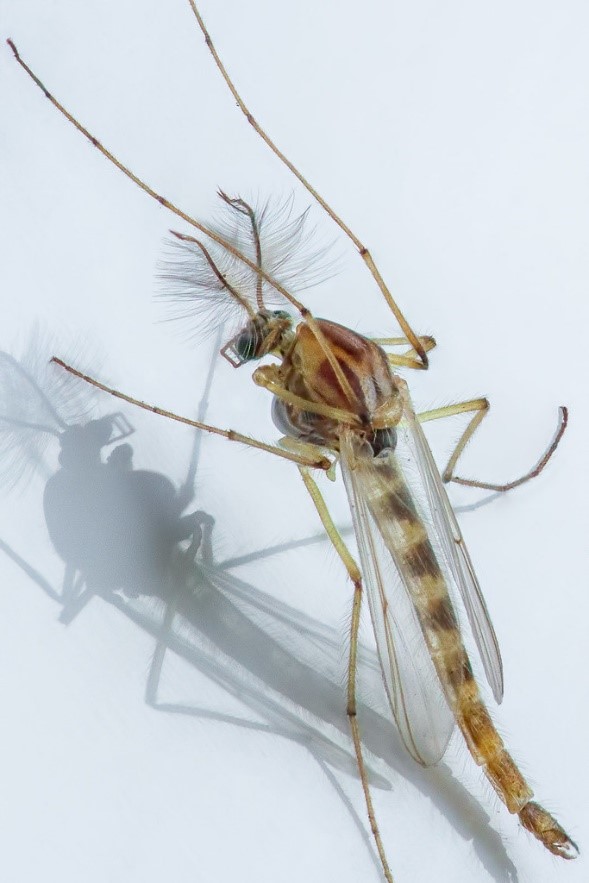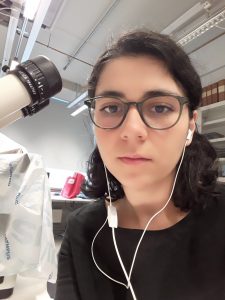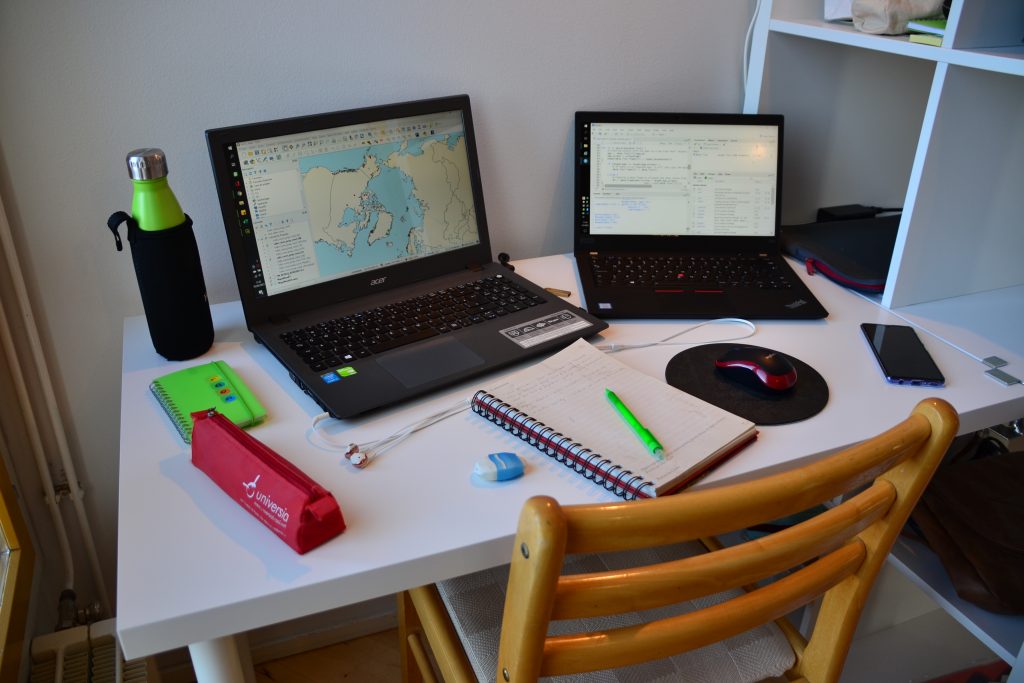By Lilia Orozco
- Chironomids are not mosquitoes
When I started my doctoral research, I did not really know what chironomids were. I think I might have seen them in nature (my very first experience!) and confused them with something else. Chironomids are part of the same insect order as mosquitoes and flies, Diptera (1). Chironomids look like mosquitoes, but do not be mistaken: they lack the tube-like sucking mouth and do not bite, hence the name of non-biting midges. Chironomids are ubiquitous as long as there is enough moisture. Adults live only from a few days to a few weeks. As larvae, they live on the bottom of water bodies from rivers and lakes to puddles and sewage systems where they serve as food source for other animals, forming an important part of the food web.

- Paleoecologists study remains of chironomid larvae
Forget the study of fossil fake mosquitoes: paleoecologists are not in the search of wings and legs. Instead, chironomid larval stage has a hard head capsule that preserves well in lake sediments. Paleoecologists find them in ample amounts in sediment cores in comparison to other insect remains, which has generated many applications for chironomid head capsules in reconstruction of past environments since the late 1920s (2). The concept is simple, as larvae they live in the water, and consequently the aquatic environment has a strong influence on the species present and their abundance (1). Chironomids are sensitive to physical and chemical properties of the water; some species are indicators of water quality, while others are only found at certain depths or oxygen levels. However, it is summer climate what mostly determines the species distribution (3).

The particular ecologies and niches of the different chironomid species make them robust environmental indicators. In the early applications, chironomids were used as indicators of changes in trophic level and salinity. It took 40 years for the method to develop and establish. It was between 1980s and 1990s that scientists started to use chironomid assemblages as a proxy for climate, in particular summer temperatures (1). A notable disadvantage of the method, however, is the time it takes to prepare the microscope slides and identify fossil head capsules. One has to hand pick each individual tiny skull from the sediments before mounting them on the microscope slides.
- Oxygen isotopic composition of chironomid remains tracks that of past lake water
A more recent paleoecological application utilizes the chemical composition of head capsules (my current learning process!). They are made of chitin (C8H13O5N), an organic compound with a similar function as the keratin in our hair and nails. The isotopic composition of carbon, oxygen or nitrogen in the chitinous head capsules can be used to reconstruct changing environmental conditions as well. The δ13C and δ15N reflect their diet (4), and can be used to study sources of organic matter, and past food webs (5). Some genera (Chironomus, Stictochironomus and Propsilocerus) absorb C from methane, and have been used to infer past methane abundance and cycling (5, 6). We are interested in the δ18O, as 70% of it comes from the water the larvae grow in (7). Water stable isotope ratios (δ2H and δ18O) can give us an insight into past hydrological dynamics affecting the lake, more specifically precipitation amount and source, as well as summertime evaporation, both of which also control lake levels and catchment dynamics. Thus, we can study hydroclimatology through changes in the isotopic composition of past lake water recorded in the head capsules.
In our present study, the lake area is considerably smaller than the catchment, which usually results in a short water residence time. Because of it, we can assume that the isotopic composition of lake water is sensitive to changes in regional hydroclimate resulting in e.g. higher or lower lake levels and changes in seasonality. In our project more broadly (Beyond the shore: sea-ice change and lake ecosystems in the Arctic or SLEET, funded by the Academy of Finland), we are studying how changes in past sea-ice cover influences lake ecosystems through the hydrological cycle.

The road to retrieve the isotopic composition of the past lake water from chironomid head capsules requires fine motor coordination and perseverance. Before measuring the δ18O from the fossils, I first have to separate them from the rest of the sediments and clean them. This is how I spend my days at the moment: I sit in front of the microscope, and with a pair of sharp tweezers and patience, I inspect the rinsed sediment in search of as many head capsules as I possibly can find. For producing a summer temperature reconstruction based on species assemblages, typical studies count and identify between 50 and 200 head capsules per sample. For measuring the oxygen isotopic composition, however, we need a minimum of 80 µg of head capsule mass, which sounds like a very small amount but requires from 100 to up to 800 head capsules and fragments depending on the size. In addition, the abundance of remains in the sediments can vary greatly. It is a long journey, and I anticipate that the results we will get will feel equally rewarding.
Lilia is a PhD student who listens to podcasts while working on the microscope.
NOTE: Isotopes are atom variations of the same element. They have the same number of protons and electrons, but a different number of neutrons, which results in mass differences among the isotopes. Usually some isotopes are more abundant than others, for example 99.76% of the oxygen in nature is 16O, while only 0.20% is 18O. The delta-value notation is the ratio between the less common isotope, and the most abundant, and to a standard value. Because these values are still too small, they are reported as per mil. We can use stable isotopes because of their mass differences. During physical and biological processes the light and heavy isotopes fractionate, they separate. Take boiling water as an example, it takes less energy to evaporate water molecules with light isotope 16O, than with heavier isotope 18O.
References:
- Brooks SJ, 2006. Fossil midges (Diptera: Chironomidae) as palaeoclimatic indicators for the Eurasian region. Quaternary Science Reviews 25: 1894–1910. https://doi.org/10.1016/j.quascirev.2005.03.021
- Gams H, 1928. Die Geschichte der Lunzer Seen, Moore und Wälder. Vorläufige Mitteilung. Internationale revue der gesamten Hydrobiologie und Hydrographie 18:349–387.
- Goedkoop W, ÅKerblom N, Demandt MH, 2006. Trophic fractionation of carbon and nitrogen stable isotopes in Chironomus riparius reared on food of aquatic and terrestrial origin. Freshwater Biology 51:878–886. https://doi.org/10.1111/j.1365-2427.2006.01539.x
- Heiri O, Schilder J, van Hardenbroek M, 2012. Stable isotopic analysis of fossil chironomids as an approach to environmental reconstruction: state of development and future challenges. Fauna norvegica 31:7–18. http://dx.doi.org/10.5324/fn.v31i0.1436
- van Hardenbroek M, Heiri O, Grey J, Bodelier PL, Verbruggen F, Lotter AF, 2010. Fossil chironomid δ13C as a proxy for past methanogenic contribution to benthic food webs in lakes? Journal of Paleolimnology 43:235–245.
- Walker IR, 2006. Chironomid Overview. Elsevier, Cambridge, UK.
- Wang YV, O’brien D, Jenson J, Francis D, Wooller M, 2009. The influence of diet and water on the stable oxygen and hydrogen isotope composition of Chironomidae (Diptera) with paleoecological implications. Oecologia 160:225–233.



